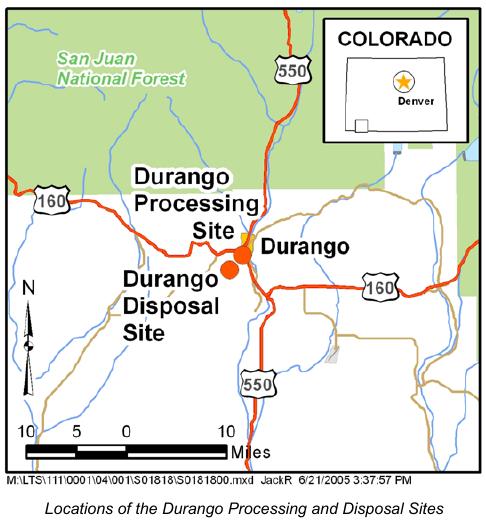The EEOICPA was passed in 2000. It provides compensation to workers who became ill as a result of their employment manufacturing nuclear weapons in the USA, as well as their spouses, children, and grandchildren. Uranium Mill in Durango EEOICPA coverage is available for qualified former Workers and their families.
Are you eligible for compensation? If you or a family member worked at this or another DOE facility and became ill, you may be entitled to compensation of up to $400K plus medical benefits. Call EEOICPA Counsel Hugh Stephens at 1-855-548-4494 or fill out our free claim evaluation, We can help even if you’ve already filed, even if your claim was denied!
Here, we have compiled publicly available information and documentation about the facilities covered by the Act to clarify how their activities relate to the Energy Employees Occupational Illness Compensation Program Act.
Uranium Mill in Durango
State: Colorado
Location: Durango
Time Period: 1948-1953; Remediation October 1986 – May 1991
Facility Type: Department of Energy
Facility Description: The AEC purchased the 147-acre uranium mill site in Durango, Colorado, in 1948 from the Vanadium Corporation of America. The AEC leased the facility back to Vanadium that same year, with an option to purchase the facility in 1953. Between 1948 and 1953, Vanadium operated the mill on behalf of the AEC. The company exercised its purchase option in 1953, and thereafter, the mill was operated as a privately owned facility. The company shut down and dismantled the mill in March 1963.
Additionally, from October 1986 through May 1991, DOE environmental remediation contractors performed environmental remediation, under the Uranium Mill Tailings Radiation Control Act (Public Law 95-604) at this mill. DOE and DOE contractor employees who performed this remediation are covered under EEOICPA.
Contractors: The Vanadium Corporation of America (1948-1953).
Listing:
The Uranium Mill in Durango is listed as a Department of Energy (DOE) site under the EEOICPA.
Compensation:
As of 06/07/15 the total compensation paid under Parts B and E of the EEOICPA, including medical compensation, for workers suffering from the effects of having worked at the BONUS Reactor Plant is $2,647,010
*Site Description and History:
The Durango processing site is a former uranium-ore processing facility located a quarter of a mile southwest of the city of Durango, Colorado. The site consists of two separate areas: the mill tailings area and the raffinate ponds area. Both areas are located on the west bank of the Animas River and are immediately southwest of the intersection of U.S. Highways 160 and 550. A narrow terrace above the Animas River connects the two areas.
The facility was constructed on the site of a former lead smelter that operated from 1880 to 1930. Vanadium Corporation of America constructed and operated the mill from 1942 to 1946 to produce vanadium. Between 1949 and 1963, the mill processed uranium ore for U.S. Government national defense programs. Milling operations produced about 1.2 million cubic yards of radioactive mill tailings, a predominantly sandy material. The tailings contaminated about 33 acres and raffinate liquids (the spent solution remaining after removing of uranium and vanadium by solvent extraction) contaminated about 20 acres. The City of Durango owns the former mill tailings area property, and the Animas-La Plata Water Conservancy District owns the former raffinate ponds area.
From 1986 to 1991, the U.S. Department of Energy (DOE) removed tailings and other contaminated materials from the Durango processing site and local contaminated properties (known as vicinity properties) and stabilized them in a disposal cell located 3.5 miles southwest of Durango. The disposal cell occupies about 42 acres of a 120-acre disposal site that was transferred from the State of Colorado to DOE. The former mill tailings and raffinate ponds areas were contoured and reseeded with native grasses after the tailings piles and contaminated soils were removed.
Some residual contamination was left in place in two regions along the bank of the Animas River, in unreachable areas of windblown contamination on the adjacent slope of Smelter Mountain and in soils of the raffinate ponds area.


















